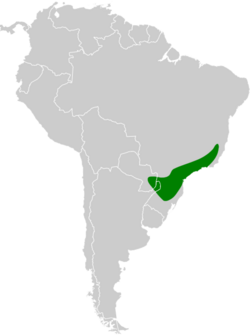Biology:White-browed foliage-gleaner
| White-browed foliage-gleaner | |
|---|---|
| Scientific classification | |
| Domain: | Eukaryota |
| Kingdom: | Animalia |
| Phylum: | Chordata |
| Class: | Aves |
| Order: | Passeriformes |
| Family: | Furnariidae |
| Genus: | Anabacerthia |
| Species: | A. amaurotis
|
| Binomial name | |
| Anabacerthia amaurotis (Temminck, 1823)
| |

| |
| Synonyms | |
|
Philydor amaurotis (Temminck, 1823) | |
The white-browed foliage-gleaner (Anabacerthia amaurotis) is a Near Threatened species of bird in the Furnariinae subfamily of the ovenbird family Furnariidae.[2][1] It is found in Argentina, Brazil, and possibly Paraguay.[3]
Taxonomy and systematics
The white-browed foliage-gleaner was previously included in genus Philydor but a 2011 paper made it plain that it did not belong there. The same paper found the ochre-breasted foliage-gleaner (A. lichtensteini) and the white-browed to be sister species.[4]
The white-browed foliage gleaner is monotypic.[2]
Description
The white-browed foliage-gleaner is 15 to 16 cm (5.9 to 6.3 in) long. It is a medium-sized furnariid with a wedge-shaped bill. The sexes have the same plumage. Adults have a wide buff-white supercilium, a dark brown band behind the eye, and an indistinct brown "moustache" on an otherwise lightly flecked and streaked, light buff, face. Their crown is brown with black-edged white feathers at the center of the back, and they have a narrow pale buff collar that extends onto the side of their neck. Their back is rich medium brown, their rump a slightly paler brown, and their uppertail coverts rufous. Their tail is rufous with bare shafts at the very end of the feathers. Their wings are rich medium brown with darker brown primary coverts. Their throat is creamy whitish, their breast light brown with wide but blurry pale buff streaks, their belly unstreaked light brown, and their flanks and undertail coverts slightly darker brown with a rufescent tinge. Their iris is dark brown, their bill pale horn with some pale gray, and their legs and feet brownish cream to cream-tinged olive.[5][6]
Distribution and habitt
The white-browed foliage-gleaner is found from Espírito Santo in southeastern Brazil south into Rio Grande do Sul and Argentina's Misiones Province. Though some taxonomic systems also include southeastern Paraguay in the species' range, the South American Classification Committee of the American Ornithological Society treats it as hypothetical in that country because the records are undocumented.[5][2][7][3] In much of its Brazilian range the species inhabits montane evergreen forest and tall secondary forest. At the southern end of its range in Brazil, Argentina, and apparently Paraguay, it inhabits lowland and hilly forest. In elevation it ranges mostly from 600 to 1,500 m (2,000 to 4,900 ft) but locally is found down to sea level.[5][6]
Behavior
Movement
The white-browed foliage-gleaner is a year-round resident throughout its range.[5]
Feeding
The white-browed foliage-gleaner feeds on adult and larval arthropods. It usually forages as part of mixed-species feeding flocks, and usually in the forest's understory though it will feed as high as the subcanopy. It acrobatically gleans, probes, and pecks for its prey in dead leaves, debris, and branches. It occasionally will sally a short distance from a perch to capture prey.[5][6]
Breeding
Nothing is known about the white-browed foliage-gleaner's breeding biology.[5]
Vocalization
The white-browed foliage-gleaner's song is "a short, accelerated, ascending and descending series of very/ext. high 'seep' notes". Its call is an "extr. high, thin 'steep tseep seepseep -' ".[6]
Status
The IUCN has assessed the white-browed foliage-gleaner as Near Threatened. It has a limited range and an unknown population size that is believed to be decreasing. The main threat is the continuing clearing of the Atlantic Forest for agriculture, industrialization, and urban expansion. The species "is now largely confined to a number of protected areas".[1] It is considered rare to fairly common in most areas but "definitely rare and local" in the lower elevation southern part of its range.[5]
References
- ↑ 1.0 1.1 1.2 BirdLife International (2016). "White-browed Foliage-gleaner Anabacerthia amaurotis". IUCN Red List of Threatened Species 2016: e.T22702843A93891938. doi:10.2305/IUCN.UK.2016-3.RLTS.T22702843A93891938.en. https://www.iucnredlist.org/species/22702843/93891938. Retrieved 29 August 2023.
- ↑ 2.0 2.1 2.2 Gill, Frank; Donsker, David; Rasmussen, Pamela, eds (July 2023). "Ovenbirds, woodcreepers". https://www.worldbirdnames.org/new/bow/ovenbirds/.
- ↑ 3.0 3.1 Remsen, J. V., Jr., J. I. Areta, E. Bonaccorso, S. Claramunt, G. Del-Rio, A. Jaramillo, D. F. Lane, M. B. Robbins, F. G. Stiles, and K. J. Zimmer. Version 31 May 2023. Species Lists of Birds for South American Countries and Territories. https://www.museum.lsu.edu/~Remsen/SACCCountryLists.htm retrieved May 31, 2023
- ↑ Derryberry, E. P., S. Claramunt, G. Derryberry, R. T. Chesser, J. Cracraft, A. Aleixo, J. Pérez-Emán, J. V. Remsen, Jr., and R. T. Brumfield. (2011). Lineage diversification and morphological evolution in a large-scale continental radiation: the Neotropical ovenbirds and woodcreepers (Aves: Furnariidae). Evolution 65(10):2973–2986.
- ↑ 5.0 5.1 5.2 5.3 5.4 5.5 5.6 Remsen, Jr., J. V. (2020). White-browed Foliage-gleaner (Anabacerthia amaurotis), version 1.0. In Birds of the World (J. del Hoyo, A. Elliott, J. Sargatal, D. A. Christie, and E. de Juana, Editors). Cornell Lab of Ornithology, Ithaca, NY, USA. https://doi.org/10.2173/bow.whbfog1.01 retrieved August 29, 2023
- ↑ 6.0 6.1 6.2 6.3 van Perlo, Ber (2009). A Field Guide to the Birds of Brazil. New York: Oxford University Press. pp. 220. ISBN 978-0-19-530155-7.
- ↑ Clements, J. F., T. S. Schulenberg, M. J. Iliff, T. A. Fredericks, J. A. Gerbracht, D. Lepage, S. M. Billerman, B. L. Sullivan, and C. L. Wood. 2022. The eBird/Clements checklist of birds of the world: v2022. Downloaded from https://www.birds.cornell.edu/clementschecklist/download/ retrieved November 10, 2022
Wikidata ☰ Q368942 entry
 |


